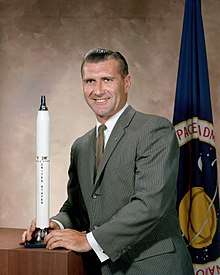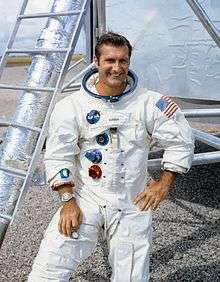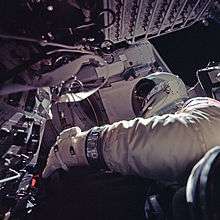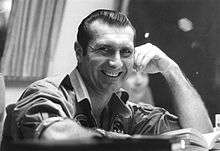Richard F. Gordon Jr.
| Richard F. Gordon Jr. | |
|---|---|
 | |
| NASA Astronaut | |
| Nationality | American |
| Born |
Richard Francis Gordon Jr. October 5, 1929 Seattle, Washington, U.S. |
| Died |
November 6, 2017 (aged 88) San Marcos, California, U.S. |
Other names | Dick Gordon |
Other occupation | Naval aviator, test pilot |
|
University of Washington (B.S. 1951) Naval Postgraduate School | |
| Rank |
|
Time in space | 13d 03h 53m |
| Selection | 1963 NASA Group 3 |
Total EVAs | 2 |
Total EVA time | 2 hours 41 minutes |
| Missions | Gemini 11, Apollo 12 |
Mission insignia |
|
| Retirement | January 1, 1972 |
| Awards |
Distinguished Flying Cross (2) Distinguished Service Medal NASA Distinguished Service Medal NASA Exceptional Service Medal |
| Website | http://www.dickgordon.com |
Richard Francis Gordon Jr. (October 5, 1929 – November 6, 2017) was an American naval officer and aviator, chemist, test pilot, and NASA astronaut. He was one of only 24 people to have flown to the Moon, as the Command Module Pilot for the Apollo 12 mission. He also flew in space in 1966 as the Pilot of the Gemini 11 mission.
Biography
Early life and education
Richard Francis Gordon Jr. was born in Seattle, Washington, on October 5, 1929, the first of five children of Richard Francis Gordon Sr., a machinist, and his wife, Angela, an elementary school teacher.[1] He was a Boy Scout, and earned the rank of Star Scout.[2] He graduated from North Kitsap High School in Poulsbo, Washington, in 1947, then entered the University of Washington, from where he received a Bachelor of Science degree in chemistry in 1951.[3]
Naval career
Gordon joined the United States Navy, and received his wings as a Naval Aviator in 1953. He then attended All-Weather Flight School and jet transitional training, and was subsequently assigned to an all-weather fighter squadron at Naval Air Station Jacksonville, Florida.[3]
In 1957, he attended the United States Naval Test Pilot School at Naval Air Station Patuxent River, Maryland, and served as a flight test pilot until 1960. During this tour of duty, he did flight test work on the F-8U Crusader, F-11F Tiger, North American FJ Fury, and A-4D Skyhawk, and was the first project test pilot for the F4H-1 Phantom II. He served with Fighter Squadron 121 (VF-121) at the Naval Air Station Miramar, California, as a flight instructor in the F4H-1 and participated in the introduction of that aircraft to the Atlantic and Pacific Fleets. He was also flight safety officer, assistant operations officer, and ground training officer for Fighter Squadron 96 (VF-96) at Miramar. He logged more than 4,500 hours flying time with 3,500 hours of those hours in jet aircraft. He was also a student at the Naval Postgraduate School at Monterey, California.[3]
He won the Bendix Trophy race from Los Angeles to New York City in May 1961, in which he established a new speed record of 869.74 miles per hour and a transcontinental speed record of 2 hours and 47 minutes.[3]
NASA career

Gordon was one of the third group of astronauts, named by NASA in October 1963. He had been a finalist for the second selection, in 1962.[3]
Project Gemini

Gordon served as backup Pilot for the Gemini 8 flight. In September 1966, he made his first space flight, as Pilot of Gemini 11, alongside Pete Conrad. At the time, the flight set an altitude record of 1,369 kilometres (851 mi), which still stands as the highest-apogee earth orbit ever.[4][5] Gordon was already good friends with Conrad, who had once been his roommate on the aircraft carrier USS Ranger. On the flight, Gordon performed two spacewalks, which included attaching a tether to the Agena and retrieving a nuclear emulsion experiment package.[3]
Apollo program
Gordon was subsequently assigned as backup Command Module Pilot for Apollo 9. In November 1969, he flew as Command Module Pilot of Apollo 12, the second manned mission to land on the Moon. While his crewmates, Pete Conrad and Alan Bean, landed in the Ocean of Storms, Gordon remained in lunar orbit aboard the Command Module, Yankee Clipper, photographing tentative landing sites for future missions.[3]
After Apollo 12, Gordon was assigned as backup Commander of Apollo 15. He was slated to walk on the Moon as Commander of Apollo 18, but that mission was canceled because of budget cuts.[6]
_Pete_Conrad%2C_Dick_Gordon%2C_and_Al_Bean_pose_with_the_Apollo_12_Saturn_V.jpg)
Gordon logged a total of 315 hours and 53 minutes in space, of which 2 hours and 41 minutes were spent in EVA.[3] He retired from NASA and the U.S. Navy in January 1972.[3]
Astronaut office
After his flights, Gordon worked in the astronaut office. He became the chief of advanced programs in 1971. Gordon worked on the design of the Space Shuttle.[7]
Post-NASA career
After leaving NASA, Gordon served as Executive Vice President of the New Orleans Saints Professional Football Club in the National Football League (1972–1976);[1] was General Manager of Energy Developers, Limited (EDL), a Texas Partnership involved in a joint venture with Rocket Research Corporation for the development of a liquid chemical explosive for use in the oil and gas industry (1977); President of Resolution Engineering and Development Company (REDCO), which provided design and operational requirements for wild oil well control and fire fighting equipment onboard large semisubmersible utility vessels (1978); following REDCO merger with Amarco Resources, Gordon assumed the additional duties of Vice President of Marketing, Westdale, an oil well servicing subsidiary of AMARCO operating in North Central Texas and Oklahoma, and also served as Vice President for Operations, Texas Division (1980); served as Director, Scott Science and Technology, Inc., Los Angeles Division (1981–1983).[3]
In March 1982 he became President of Astro Sciences Corporation. This company provides a range of services including engineering, project management, project field support teams, to software and hardware system design for control room applications. In the summer of 1984, Gordon was a Technical Advisor for and played the part of "Capcom" in the CBS miniseries Space by James A. Michener.[3]
Gordon served as Chairman and co-Chairman of the Louisiana Heart Fund, Chairman of the March of Dimes (Mother's March), Honorary Chairman for Muscular Dystrophy, and on the boards of directors for the Boy Scouts of America and Boys' Club of Greater New Orleans.[3]
Personal life and death
From his marriage (which ended in divorce) to his first wife Barbara Field, who died in 2014, Gordon had six children.[1][8] He died in San Marcos, California on November 6, 2017, at the age of 88.[1][5][9] He was survived by five of his children, Carleen Trevino, Richard, Lawrence, Thomas and Diane Briggs; his sisters Barbara Pethick and Mary Frederick, and brother Norman; and two stepchildren, Traci and Christopher, from his second wife Linda,[1] who died on September 12, 2017.[9] His hobbies included water skiing and golf.[3]
Organizations
Gordon was a fellow of the American Astronautical Society, an associate fellow of Society of Experimental Test Pilots and a member of the Navy League.[3]
Awards and honors
- Navy Astronaut Wings[3]
- NASA Distinguished Service Medal[3]
- NASA Exceptional Service Medal[3]
- Bendix Trophy in 1961[3]
- Two Navy Distinguished Flying Crosses[3]
- Navy Distinguished Service Medal[3]
- Phi Sigma Kappa Merit Award in 1966[3]
- Institute of Navigation Award for 1969[3]
- Godfrey L. Cabot Award in 1970[3]
- Rear Admiral William S. Parsons Award for Scientific and Technical Progress in 1970[3]
- Manned Spacecraft Center (MSC) Superior Achievement Award
- NASA Group Achievement Award[3]
- Richard Gordon Elementary School in Kingston, Washington was named after him.[10]
- Inducted into the International Space Hall of Fame, 1982[11]
- Gordon was inducted into the United States Astronaut Hall of Fame on March 19, 1993.[12]
In media
In the 1998 HBO miniseries From the Earth to the Moon Gordon was played by Tom Verica.[13]
Books authored
Gordon wrote the foreword of the book Falling to Earth: An Apollo 15 Astronaut's Journey to the Moon by fellow Apollo astronaut Al Worden,[14] as well as the foreword to Footprints in the Dust.[15]
Technical papers

- Gordon, R. F., F4H-1 Navy Preliminary Evaluation, Phase I, NAS Patuxent River, Maryland, September 1958.
- Gordon, R. F., F4H-1 Navy Preliminary Evaluation, Phase I Supplement, October 1958.
- Gordon, R. F., FJ-4B Fuel Consumption and Performance Report, Flight Test, NAS Patuxent River, Maryland, 1958.
- Gordon, R. F., F11F Fuel Consumption and Performance Report, Flight Test, NAS Patuxent River, Maryland, 1958.
- Gordon, R. F., Revised Roll Performance Requirements for MIL-SPEC-F-8785. All Aircraft in Configuration PA, Flight Test, NAS Patuxent River, Maryland, 1958.
- Gordon, R. F., F8U Spin Evaluation Report, Flight Test, NAS Patuxent River, Maryland, 1959.
- Gordon, R. F., Gemini XI, Gemini Program Mission Report, NASA Manned Spacecraft Center Report, October 1966.
- Gordon, R. F., Apollo XII Mission Report, NASA Manned Spacecraft Center Report, December 1969.
References
- 1 2 3 4 5 Goldstein, Richard (November 7, 2017). "Richard Gordon, Astronaut Who Reached for Moon and Very Nearly Made It, Dies at 88". New York Times. Archived from the original on November 7, 2017. Retrieved November 7, 2017.
- ↑ "Scouting and Space Exploration". Archived from the original on March 4, 2016.
- 1 2 3 4 5 6 7 8 9 10 11 12 13 14 15 16 17 18 19 20 21 22 23 24 25 "Biographical Data: Richard F. Gordon Jr". NASA. Archived from the original on August 15, 2012. Retrieved September 4, 2012.
- ↑ "Gordon". NASA. Retrieved August 14, 2016.
- 1 2 "Remembering Dick Gordon". NASA. November 7, 2017. Archived from the original on November 8, 2017. Retrieved November 9, 2017.
- ↑ "NASA Johnson Space Center Oral History Project". June 16, 1999. Archived from the original on November 8, 2017. Retrieved November 10, 2017.
- ↑ "Gordon, Richard Francis, Jr. (1929–2017)". David Darling. Archived from the original on November 9, 2017. Retrieved November 9, 2017.
- ↑ "Barbara Field Gordon Obituary". Asheville Mortuary Service. Archived from the original on 8 November 2017. Retrieved 7 November 2017.
- 1 2 "Richard Francis "Dick" Gordon Jr., Apollo Astronaut, Naval Aviator & 'Renaissance Man', Dies At 88". Astronaut Scholarship Foundation. Archived from the original on November 8, 2017. Retrieved November 7, 2017.
- ↑ "About Richard Gordon". Richard Gordon Elementary School. Archived from the original on November 10, 2017. Retrieved November 8, 2017.
- ↑ "Richard Gordon". New Mexico Museum of Space History. Archived from the original on November 9, 2017. Retrieved November 8, 2017.
- ↑ "Dick Gordon". Astronaut Scholarship Foundation. Archived from the original on October 2, 2017. Retrieved May 31, 2017.
- ↑ "Filmography". IMDB. Archived from the original on May 25, 2017. Retrieved November 8, 2017.
- ↑ "Falling to Earth web site". Penguin Random House. Archived from the original on July 17, 2015. Retrieved November 9, 2017.
- ↑ "Footprints in the Dust – University of Nebraska Press". University of Nebraska Press. Archived from the original on January 7, 2016. Retrieved November 9, 2017.
![]()
External links
| Wikimedia Commons has media related to Richard F. Gordon Jr.. |
- Richard F. Gordon Jr. on IMDb
- Episode 43 on astrotalkuk.org Interview during visit to the UK April 2011
- Remembering Dick Gordon
- Find a Grave